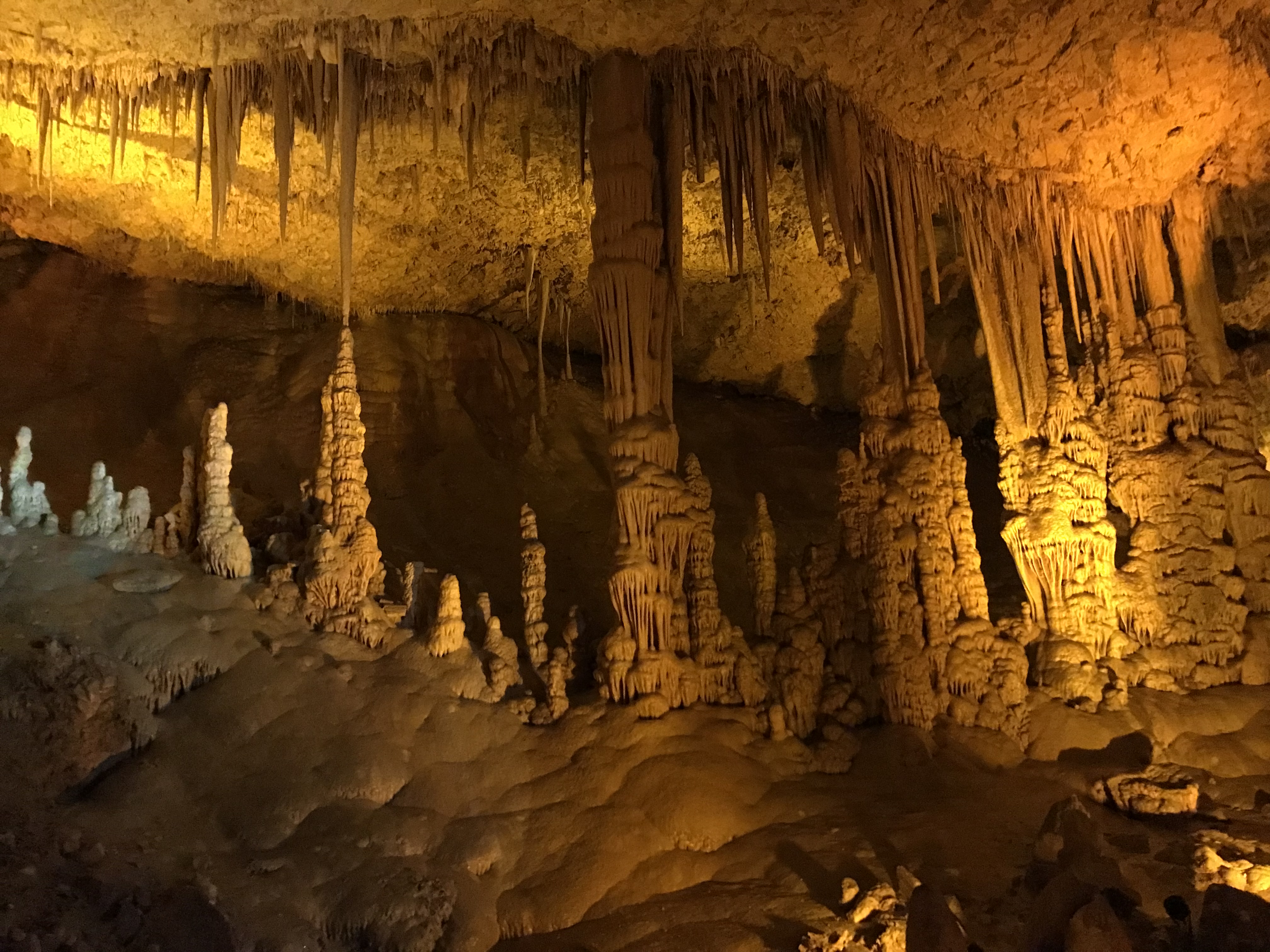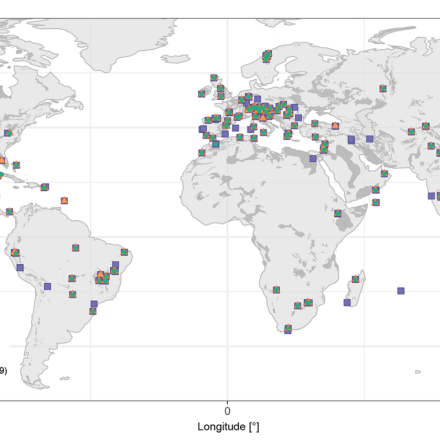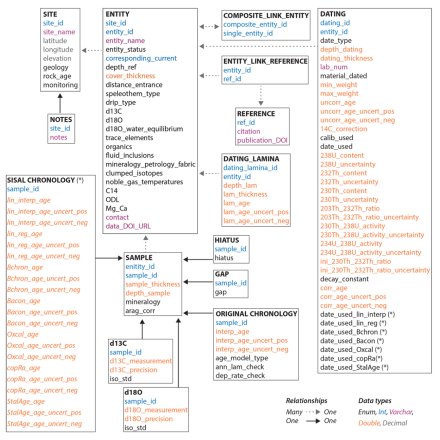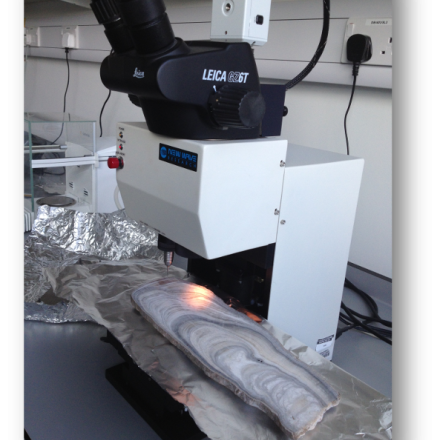Speleothems and the SISAL database: An overview of the use of speleothems as archives of climate proxies

Speleothems provide globally distributed, seasonal to multi-annual resolution climate records encoded in multiple proxies including oxygen and carbon stable isotopes, and trace elements.
Speleothems, such as stalagmites and flowstones, are secondary cave carbonate deposits. They grow by incremental deposition of layers of calcium carbonate from dripping water, and encode climatic and environmental conditions above the cave. Speleothems have provided some iconic records of past terrestrial paleoclimate available to date, including reconstructions of the Asian Summer Monsoon over the last 640,000 years (Cheng et al., 2016), of sub-orbital scale climate variability in the Alps (Moseley et al., 2020), and of short-term shifts in the meridional position of the Intertropical Convergence Zone in response to volcanic eruptions (Ridley et al., 2015).
The SISAL database versions are the most complete resource on speleothem geochemical data available. They are developed and updated periodically since 2017 by the Speleothem Isotope Synthesis and AnaLysis (SISAL) working group, an international team of scientists under the umbrella of the Past Global Changes (PAGES) project.
Key Strengths
Speleothems are globally distributed, including in highly populated regions, enabling climate reconstruction in regions where this information is vital for decision-making.
Multiple proxies inform on different climatic and environmental parameters and increase our confidence in the climatic interpretations.
Uranium-thorium and C14 dating allow for absolute chronologies going back 600,000 years. This enables precise dating and sequencing of global climate events, and the evaluation of orbital forcing.
Key Limitations
Oxygen isotopes are the most ubiquitously measured speleothem proxy, but they are not globally calibrated to a climatic parameter. This proxy often provides indirect information on changes in atmospheric circulation patterns, and needs to be assessed at a regional-to-local scale. The same is true for other proxies, such as carbon isotopes and trace element concentrations.
Attenuation of annual rainfall recharge in the karst means that speleothem oxygen isotopes generally record an 'averaged' signal of multiple years. A seasonally-dominated signal can occur if in-cave processes control the oxygen isotope signature. Disentangling these effects requires careful monitoring work, which is not always possible.
The discontinuous nature of most speleothem records means that only a limited number of records are available for traditional data-model comparison approach of comparing a control period against an experimental period.
Expert User Guidance
The following was contributed by Franziska Lechleitner and Nikita Kaushal, June, 2023:
Speleothems provide globally distributed, seasonal to multi-annual resolution climate records encoded in multiple proxies including oxygen and carbon stable isotopes, and trace elements.
General overview
Speleothems, such as stalagmites and flowstones, are secondary cave carbonate deposits. They grow by incremental deposition of layers of calcium carbonate from dripping water, and encode climatic and environmental conditions above the cave. Speleothems have given us some of the most iconic records of past terrestrial paleoclimate available to date, including reconstructions of the Asian Summer Monsoon over the last 640,000 years (Cheng et al., 2016), of sub-orbital scale climate variability in the Alps (Moseley et al., 2020), and of short-term shifts in the meridional position of the Intertropical Convergence Zone in response to volcanic eruptions (Ridley et al., 2015). These are particularly powerful given the often exceptionally precise chronologies based on U-Th dating of speleothems.
The SISAL database versions are the most complete resource on speleothem geochemical data available. They are developed and updated periodically since 2017 by the Speleothem Isotope Synthesis and AnaLysis (SISAL) working group, an international team of scientists under the umbrella of the Past Global Changes (PAGES) project.
SISALv2, the latest version of the database, contains 673 globally distributed speleothem oxygen and 430 carbon isotope records, along with extensive metadata (Comas-Bru et al., 2020). Moreover, a robust assessment of age uncertainties in the individual records and the record ensemble is possible through the development of a series of standardized chronologies (Comas-Bru et al., 2020). The database has been an invaluable resource
• for model-data intercomparison studies (Comas-Bru et al., 2019; Parker et al., 2021; Bühler et al., 2022),
• for investigations of proxy systematics, e.g. stable oxygen (Treble et al., 2022) and carbon isotopes (Fohlmeister et al., 2020), and growth rates (Baker et al., 2021).
A new version of SISAL (SISALv3) is being developed and set to be released in summer 2023, which incorporates significantly more records (902) along with additional speleothem proxies, namely trace elements and Sr isotopes.
Key strengths
● Speleothems are globally distributed, including in highly populated regions, enabling climate reconstruction in regions where this information is vital for decision-making.
● Uranium-thorium and C14 dating allow for absolute chronologies going back 600,000 years. This enables precise dating and sequencing of global climate events, and the evaluation of orbital forcing.
● Multiple advanced age-depth model algorithms allow for low chronological uncertainties and records can range from seasonal to multi-annual resolution.
● Multiple proxies inform on different climatic and environmental parameters and increase our confidence in the climatic interpretations.
● Their long time scale and absolute chronologies are also critical for the evaluation of paleoclimate models (Comas-Bru et al., 2019).
Key limitations
● Oxygen isotopes are the most ubiquitously measured speleothem proxy, but they are not globally calibrated to a climatic parameter. This proxy often provides indirect information on changes in atmospheric circulation patterns, and needs to be assessed at a regional-to-local scale. The same is true for other proxies, such as carbon isotopes and trace element concentrations.
● Attenuation of annual rainfall recharge in the karst means that speleothem oxygen isotopes generally record an 'averaged' signal of multiple years. A seasonally-dominated signal can occur if in-cave processes control the oxygen isotope signature. Disentangling these effects requires careful monitoring work, which is not always possible.
● The discontinuous nature of most speleothem records means that only a limited number of records are available for traditional data-model comparison approach of comparing a control period against an experimental period.
● Speleothem formation needs karst and dripping water. The number of speleothem records from regions with many well-decorated caves can be much higher than from other regions.
What are some common mistakes that users encounter when processing or interpreting these data?
● Local influencing factors, such as karst and in-cave processes can lead to noise in the timeseries and mask the climate signal. Studies that perform regional-to-continental scale analysis based on a few selected records may lead to erroneous interpretations. The SISAL database enables objective data selection for large scale analysis using appropriate data search criteria.
● Oxygen isotopes are the most ubiquitously measured speleothem proxy. However, unlike other archives (e.g. foraminifera), their interpretation in speleothems depends on the site and the time period covered by the record. SISAL has provided a regional interpretative framework, which helps circumvent this issue (https://www.mdpi.com/journal/quaternary/special_issues/speleothem_records_climate). The interpretation of speleothem carbon isotopes comes with similar challenges (Fohlmeister et al., 2020).
● Fast-growing stalagmites, particularly if laminated, suggest the availability of sub-annual climate proxy data. This can be misleading, as the proxy information may still not be seasonal, due to mixing of water masses in the karst over longer timescales, or seasonal biases in carbonate precipitation in the cave. In order to use such high-resolution data for analysis, it is strongly recommended to read the publications linked to the studies provided in the database.
What are likely spurious (non-climatic) features, if any, of timeseries derived from these data?
A number of processes can influence speleothem growth and proxy encoding. Mixing of water masses in the karst system will affect the oxygen isotopic signature of speleothems, and may not be directly related to climate. Different speleothems will show different variances in their signal due to different dominant dripwater pathways. Replication of a time series with at least one other speleothem from the same cave or a nearby site is therefore strongly recommended to tease out the climate signal.
Describe any conversion steps that are necessary or general strategies to compare these data with model output
Stable oxygen isotopes are the main proxy analyzed in speleothems and the only one that is also directly simulated by isotope-enabled climate models. Before comparing the speleothem oxygen isotope value to the modelled precipitation oxygen isotope value, the speleothem value needs to be corrected for isotopic fractionation occurring when carbonate precipitates from the dripwater (conversion to “dripwater equivalent”; Comas-Bru et al., 2019).
How is uncertainty characterized in these data?
Speleothems often have exceptionally precise chronologies, but some uncertainty remains due to measurement techniques or natural contamination, e.g. with detrital Th. The SISAL database systematically assessed chronological uncertainties and their effect on the proxy timeseries, by providing raw measured ages and measurement uncertainties along with an ensemble of age-depth chronologies built using different algorithms.
More generally, speleothem proxy records are affected by local processes on top of the regional climatic signal, so wherever possible, replication of a proxy record with other speleothems from the same or nearby caves is recommended. The SISAL database, with its global reach, presents the first resource to assess the climate fidelity of speleothem records on a regional-to-global scale.
Can you recommend cloud platforms/online plotting tools to visualise the data? Are there publicly available pieces of code that illustrate how to access the data?
Members of the SISAL working group have developed an app, the SISAL webApp (https://geochem.hu/SISAL_webApp/) that allows to perform simple objective database queries for regional-to-global analysis and linked data download. Moreover, the mySQL query text is provided, so the app also functions as a learning tool. The SISAL working group also published “how to” guides for accessing and querying the database (https://researchdata.reading.ac.uk/256/) using MySQL, MTALAB, R and Python. Many publications using the SISAL database are listed on the Working group’s web link (https://pastglobalchanges.org/science/wg/sisal/publications) and provide links to additional code for data analysis.
Please provide a summary statement about these data and their utility for climate research and model evaluation.
Speleothems provide some of the most precisely dated, globally distributed records of terrestrial environmental change over the last half a million year. The SISAL database is an invaluable resource that documents, collects and synthesizes the available speleothem data. This allows regional to global scale assessments of climate variability and intercomparison with model output with high temporal accuracy. ##
Cite this page
Acknowledgement of any material taken from or knowledge gained from this page is appreciated:
Kaushal, Nikita &, Lechleitner, Franziska & National Center for Atmospheric Research Staff (Eds). Last modified "The Climate Data Guide: Speleothems and the SISAL database: An overview of the use of speleothems as archives of climate proxies.” Retrieved from https://climatedataguide.ucar.edu/climate-data/speleothems-and-sisal-database-overview-use-speleothems-archives-climate-proxies on 2025-09-16.
Citation of datasets is separate and should be done according to the data providers' instructions. If known to us, data citation instructions are given in the Data Access section, above.
Acknowledgement of the Climate Data Guide project is also appreciated:
Schneider, D. P., C. Deser, J. Fasullo, and K. E. Trenberth, 2013: Climate Data Guide Spurs Discovery and Understanding. Eos Trans. AGU, 94, 121–122, https://doi.org/10.1002/2013eo130001
Key Figures
Other Information
- Baker, A., Mariethoz, G., Comas-Bru, L., Hartmann, A., Frisia, S., Borsato, A., et al. (2021). The Properties of Annually Laminated Stalagmites-A Global Synthesis. Rev. Geophys. 59, e2020RG000722. doi: 10.1029/2020RG000722
- Bühler, J. C., Axelsson, J., Lechleitner, F. A., Fohlmeister, J., LeGrande, A. N., Midhun, M., et al. (2022). Investigating stable oxygen and carbon isotopic variability in speleothem records over the last millennium using multiple isotope-enabled climate
- Cheng, H., Edwards, R. L., Sinha, A., Spötl, C., Yi, L., Chen, S., et al. (2016). The Asian monsoon over the past 640,000 years and ice age terminations. Nature 534, 640–646. doi: 10.1038/nature18591.
- Comas-Bru, L., Harrison, S. P., Werner, M., Rehfeld, K., Scroxton, N., Veiga-Pires, C., et al. (2019). Evaluating model outputs using integrated global speleothem records of climate change since the last glacial. Clim. Past Discuss. doi: 10.5194/cp-2019-2
- Comas-Bru, L., Rehfeld, K., Roesch, C., Amirnezhad-Mozhdehi, S., Harrison, S. P., Atsawawaranunt, K., et al. (2020). SISALv2: A comprehensive speleothem isotope database with multiple age-depth models. Earth Syst. Sci. Data 12, 2579–2606. doi: https://doi
- omas-Bru, L., Rehfeld, K., Roesch, C., Amirnezhad-Mozhdehi, S., Harrison, S. P., Atsawawaranunt, K., et al. (2020). SISALv2: A comprehensive speleothem isotope database with multiple age-depth models. Earth Syst. Sci. Data 12, 2579–2606. doi: https://doi.
- Fohlmeister, J., Voarintsoa, N. R. G., Lechleitner, F. A., Boyd, M., Brandtstätter, S., Jacobson, M. J., et al. (2020). Main controls on the stable carbon isotope composition of speleothems. Geochim. Cosmochim. Acta 279, 67–87. doi: 10.1016/j.gca.2020.03.
- Goldscheider, N., Chen, Z., Auler, A. S., Bakalowicz, M., Broda, S., Drew, D., et al. (2020). Global distribution of carbonate rocks and karst water resources. Hydrogeol. J. 28, 1661–1677. doi: 10.1007/s10040-020-02139-5.
- Moseley, G. E., Spötl, C., Brandstätter, S., Erhardt, T., Luetscher, M., and Edwards, R. L. (2020). NALPS19: sub-orbital-scale climate variability recorded in northern Alpine speleothems during the last glacial period. Clim. Past 16, 29–50. doi: 10.5194/c
- Parker, S. E., Harrison, S. P., Comas-Bru, L., Kaushal, N., LeGrande, A. N., and Werner, M. (2021). A data–model approach to interpreting speleothem oxygen isotope records from monsoon regions. Clim. Past 17, 1119–1138. doi: 10.5194/cp-17-1119-2021.
- Ridley, H. E., Asmerom, Y., Baldini, J. U. L., Breitenbach, S. F. M., Aquino, V. V., Prufer, K. M., et al. (2015). Aerosol forcing of the position of the intertropical convergence zone since AD 1550. Nat. Geosci. 8, 195–200. doi: 10.1038/ngeo2353.
- Treble, P. C., Baker, A., Abram, N. J., Hellstrom, J. C., Crawford, J., Gagan, M. K., et al. (2022). Ubiquitous karst hydrological control on speleothem oxygen isotope variability in a global study. Commun. Earth Environ. 3, 1–10. doi: 10.1038/s43247-022-



